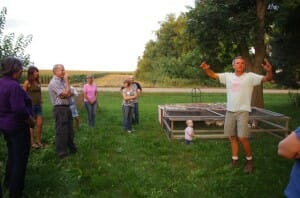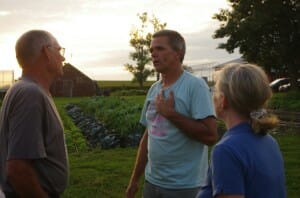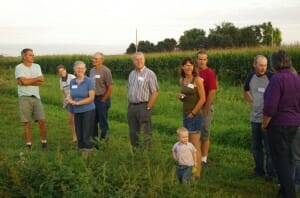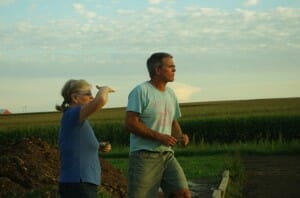Wesselius Field Day: Fall CSA Planning and Farm Productivity
John Wesselius doesn’t waste time. With a two-hour field day dedicated to planning for a fall CSA he said, “I can answer that in 30 seconds. Be ready with more questions.” True to his word, he succinctly described fall CSA planning: “Assume 60% of your summer members will continue into the fall, then plant 50% extra for market and to make sure you have enough.”
John and his wife, Janna, have always gardened, but in 2003 his wife suggested he needed a more demanding summer hobby and they moved to the country. The garden expanded, his daughters took on animal husbandry and vegetable production
as their high school jobs. By 2008 they were selling at 3 farmers markets and had CSAs in Sioux Center and Sioux City. Though John initially had doubts about the CSA model, he loves that the mid-week CSA pick-up fills the gap between the busy weekend markets, allowing him to harvest all week without having to do a slow mid-week farmers market. In each of their new CSA markets they started small, about 10 shares in each city. They now have 23 full shares and 39 half shares for the summer, and 44 full shares for the fall. The CSA also helps even out the peak season of consumer interest (in middle of summer when consumers perceive the peak of production exists), and the actual peak of production in the fall when consumers perceive the farmers’ market season to be finished.
Mercedes Ivener, a stalwart CSA member from the beginning, shared her experience and appreciation for the Wesselius’ CSA box. She appreciates the weekly challenge and surprise of the produce, but immensely values the care John puts into washing. She’s busy: a lawyer and Mom of 2 boys, and finds when vegetables are washed she uses them sooner – it takes a time consuming, messy step out of preparing a meal. She also appreciates the value of the box each week, and the excellent quality of each item.
John’s strength as a farmer, in addition to growing beautiful and delicious produce, is his attention to the value of time, labor, inputs, and quality. By working with his daughters over the years, he has developed productivity expectations for his college student employees. By knowing how long it takes himself and his daughters to harvest and wash every pound of potatoes, for example, he can clearly communicate expectations to employees and calculate profitable prices at markets and in CSA boxes. For example, it takes Jessica, his daughter, 25 minutes to fill a crate with potatoes and 12-18 minutes to wash them. From this, he determines his break-even point for potatoes is $1/lb for just the harvest, prep, and transportation to market. “If you sell potatoes for less than that, you’re paying people to take them away from you,” said Wesselius.
When deciding what to harvest for maximum profit, he uses his productivity standards to determine revenue harvested per hour. If John and his employees aren’t harvesting $40 of product per hour they stop harvesting. He takes a similar approach to the market. Though he is quite talkative and close with his CSA customers, he tries to limit most market transaction to 20 seconds -he wants to spend his time with people who buy a lot of vegetables. By doing this, he can make more sales per market with fewer employees.
John’s biggest struggle is his inability to expand production due to the limited availability of land. Right now he raises 2,300 broilers per year, 22 pigs, and 2 acres of vegetables; he would like to have 5 or 6 acres of vegetables to earn a full-time living. “Land is very expensive and tightly held,” John said about his region of Iowa.
After enjoying a delicious meal of farm-raised chicken and vegetables, field day participants toured the farm, learning about the rotations with chickens (moving chicken tractors through vegetable fields to clean up rye cover crop), discussing pig breeds, and sharing the joys and frustrations of a high tunnel Iowa celery crop. John on high tunnels: “if you have 2 or 3 acres you should have 4, 92 feet (long) is best; if you have the cash, buy them.” What I learned at the field day: If you want a straight answer to any question, ask John Wesselius (and then his wife, Janna!).





